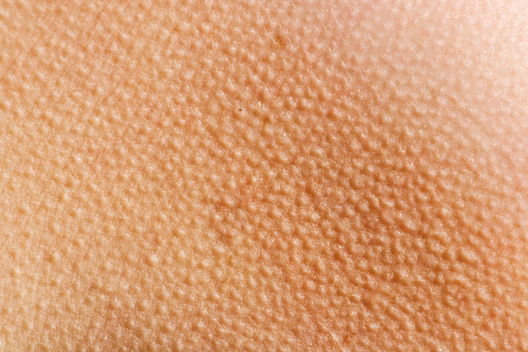Keratosis pilaris is a very common skin condition characterized by the appearance of tiny red or white bumps on the skin that are commonly found on the arms, buttocks, and legs. It is also referred to as follicular keratosis or lichen pilaris,
Keratosis pilaris bumps look very similar to small, pinpoint-like pimples but they do not hurt or itch. They are typically caused by an excessive production of keratin, which ends up accumulating in the hair follicles and developing into small bumps.
Because it is not a serious condition, keratosis pilaris does not usually require any type of specific treatment. However, it can be treated for cosmetic reasons. A family doctor or dermatologist can prescribe medicated creams that help reduce the appearance of these tiny bumps and give your skin a smoother-looking appearance.

Common causes
What causes keratosis pilaris is still not totally clear, however, the condition seems to happen due to excessive keratin production. This keratin can start to accumulate in the hair follicles and lead to the development of tiny bumps on the skin.
Keratosis pilaris tends to affect people who use tight clothes, have dry skin or have a history of another type of skin problem, such as atopic dermatitis. People who have allergic diseases, like asthma or rhinitis, also seem to present with a higher risk for developing keratosis pilaris.
A lack of vitamin A can also contribute to the development of keratosis pilaris, therefore some doctors recommend consuming foods rich in vitamin A, such as cabbage, tomato or carrots.
Main symptoms
Keratosis pilaris is characterized by the appearance of tiny red, or white, bumps on the skin. They most commonly affect the arms, legs, buttocks, or cheeks, which is where skin can become more dry and rough. Keratosis pilaris numps do not itch, hurt or cause any type of physical discomfort.
It is common for keratosis pilaris normally to appear during childhood or adolescence, and to clear up naturally at the age of 20 to 30.
Treatment options
Since it is not a serious health condition, keratosis pilaris does not usually require any type of treatment. However, if a patient wishes to pursue treatment for cosmetic reasons, the doctor or dermatologist can prescribe some creams that help hydrate the skin and reduce the appearance of these tiny bumps.
Some medical options to get rid of keratosis pilaris include:
- Creams with salicylic acid or urea, which help remove dead skin cells and promote hydration deep within the skin. The use of these types of cream can cause some redness or a burning sensation in the area where they are applied, but it clears-up in just a few minutes;
- Creams with retinoic acid or Vitamin A, which also hydrate the skin and can reduce the appearance of the tiny bumps.
Keratosis pilaris bumps tend to get smaller with time, but it can take many years for them to disappear completely. They typically resolve after the age of 30.
There are also some simple lifestyle changes that can help with reducing the appearance of the tiny bumps, such as avoiding very hot or long showers, hydrating the skin after taking a bath and preventing excessive friction from clothes and towels. It is also recommended to avoid prolonged sun exposure in the sun and to use sunscreen daily.






























